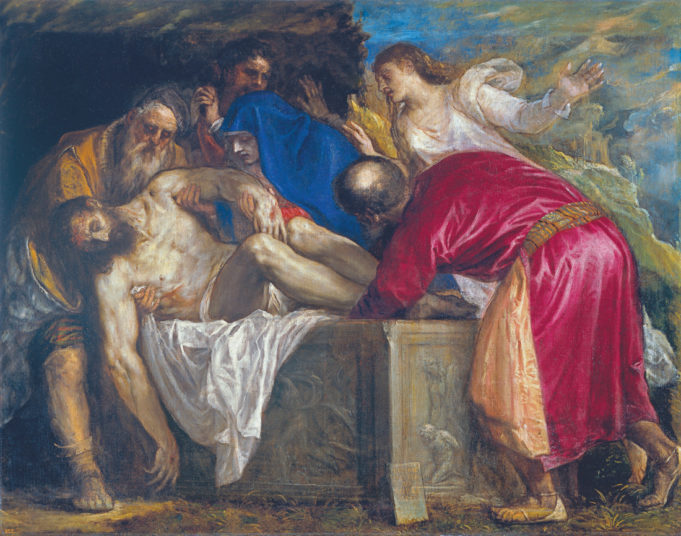When the Kimbell Art Museum announces it has taken a Titian painting on loan, you take notice. However, when it’s one of the 16th-century Venetian master’s greatest works on loan from the breathtaking Museo del Prado in Madrid, that compels your full attention. Titian’s “Entombment of Christ” now hangs prominently in the Kimbell, a priceless piece of art history that will remain here for the season.
The Prado’s picture dates to 1559, when the artist was somewhere around 70 years old and had landed in the good graces of Philip II, who had recently been crowned king of Spain. Philip’s father, Charles V, had begun the Spanish royal family’s art collection that would, centuries later, become the basis of the Prado. Whatever his failings as a ruler and as a man, Philip had a discerning and adventurous taste in art, and he added greatly to the collection. Titian had previously painted pictures for Charles, but it was Philip who would prove to be the artist’s greatest patron, despite the disparity in their ages. The Kimbell’s labeling does not tell you that “The Entombment of Christ” is somewhat atypical of the work Titian did for Philip. Many of the paintings Titian produced for the prince were erotic in nature, like his lush painting of the Greek nymph “Danaë.” Philip may have been raised a strict Catholic, but he was still in his early 30s and was hardly the first religious man to enjoy looking at sexy pictures.
The “Entombment,” though, was another matter. Titian had painted the subject before, in the 1520s, a dusky and highly coloristic study that currently hangs in the Louvre. (That older painting has been neglected, possibly because it hung for decades next to the Mona Lisa.) Philip commissioned another one from Titian, in 1557, shortly after being crowned king of Spain, but he never saw it — that painting wound up being lost en route to present-day Belgium, where the monarch was overseeing Spain’s holdings. The Prado’s picture was commissioned as a replacement for the lost one, and this somber piece is clearly the work of an artist who has grown older and more reflective. The Venetian’s vaunted mastery of color is still in evidence, here in the burgundy robe worn by Joseph of Arimathea (who is seen holding Christ’s feet) and the deep blue one worn by the Virgin Mary. However, a more prevalent color is the gray in the darkening sky, the marble slab that Christ is resting on, and the cave where he’s to be interred. Mary Magdalene is clad counterintuitively in white, which is echoed in the cloth underneath Christ that will become his shroud.
The gray-bearded figure of Nicodemus, who is seen taking Christ’s upper body, is generally thought to be a self-portrait of the artist, bearing a strong resemblance to the self-portraits that Titian painted at this time. This isn’t merely the painter inserting himself into the Christ story — medieval legends made Nicodemus out to be an artist who carved likenesses of Jesus, so subsequent artists felt a kinship with the Biblical figure. Indeed, Michelangelo put his own face on Nicodemus in his unfinished Pietà in Florence Cathedral.
The muscular Christ’s dead weight makes the entire painting seem to be collapsing on its left side. It’s an effect of Titian’s skillful sense of composition, as the artist also depicts the sky darkening on the left and Mary Magdalene seemingly propelled by her grief across the frame from right to left. The heaviness of the body brings home the size of Christ’s sacrifice and creates an atmosphere of deep sadness and mourning. Philip ended up taking the painting to his own personal palace, the Escorial, where he hung it in a private chapel that was visible from his bedroom. We can only guess what effect this work had on the mind of a devout king who presided over a splendid flowering of Spanish literature and the arts but also over the ruthless repression of non-Catholics in Spain and the genocide of native peoples in the Americas. Thanks to the Kimbell’s loan from the Prado, we now have time to contemplate these questions in front of a masterwork of the Renaissance.












